Out & About The Bay – by Jillian Humphreys

Let’s Go Sail A Small Boat
Sail a Small Boat Day started in the early 90s when a few Richmond Yacht Club members combined a few events that were already popular to make a super event. Del Olson, Rand Arnold and a handful of passionate dinghy sailors are the ones who made this annual event something that sailors and non-sailors around the San Francisco Bay look forward to every spring. The annual event has only been canceled once in its 30-year run, and that was in 2020. It was postponed in 2021 until December due to the restrictions that COVID presented.
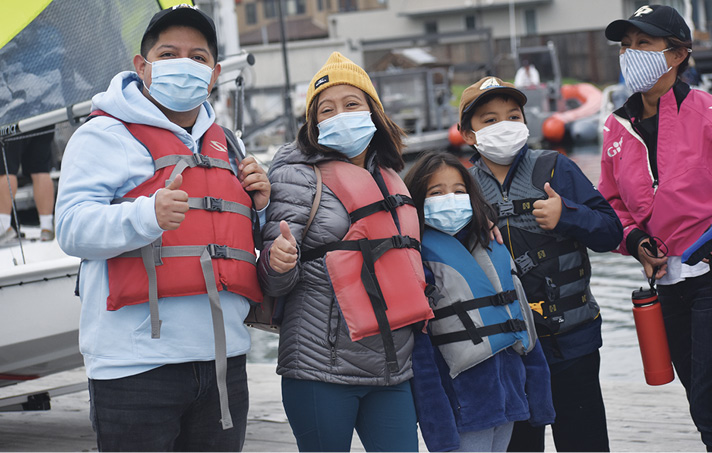
Richmond Yacht Club is not looking to generate new membership from the event, even though they do see new faces from time to time. Satisfaction is achieved by watching the families going out on the Alerion 28s and enjoying a peaceful sail around the Richmond Riviera. Fortunately, this year the winds were calm. Kids that were of age were able to try out the smaller boats including El Toros and Optimists by themselves. The eight-foot dinghies are used as training boats in Richmond Yacht Club’s junior program.
Imagine looking up to a parent that you never really got to know and finding a way to connect to them by chance. When 2-year-old Zachary Peterson of Brentwood lost his father, he grew up wanting to make his father proud. Richmond Yacht Club’s Sail A Small Boat Day has made this now 9-year-old’s dream reality. Peterson is now enrolled in the Richmond Yacht Club award winning junior program and is excited as this will be his first year since COVID delayed this opportunity last year. Watching new sailors and old salts get out on the water and experience Sail A Small Boat Day was something magical and made the inner coach in me beam with joy.
Laurie Davis is the woman behind the scenes that makes this event what it is, even though it is a committee wide effort within Richmond Yacht Club’s Sailing Advisory Committee. Laurie has assisted with the last three Sail A Small Boat Days under the guidance of Eric Arens. In “normal” years the wind is steady as March brings in the spring winds, but this year was overcast and misty with the occasional sprinkle of rain. That did not stop 112 people from coming out and enjoying a day out on the water.
The sun finally poked out around noon and the breeze was trying to fill in. Participants lining up for sailboat rides were required to check in, get fitted with life jackets and make their way to the dock to see what boat they would like to try out. In some cases, they were able to try out more than one boat. All attendees followed the masking protocols, and those eligible were required to be fully vaccinated. This allowed for a safe event for everyone. Richmond Yacht Club served up a free hot dog and chip lunch for all participants outside on the upper deck.
Richmond Yacht Club is looking forward to having new smiling faces come out in March. You can visit www.richmondyc.org for information or updates if you wish to come out and help celebrate Sail A Small Boat Day in 2022.
The Petaluma River Is Growing
The Petaluma River goes through the California counties of Sonoma and Marin. Almost all of it is a tidal slough. The flow is generally southward through the City of Petaluma’s old town, and that is where the waterway becomes navigable. After that the river flows about another ten miles through marshland before it empties into San Pablo Bay.
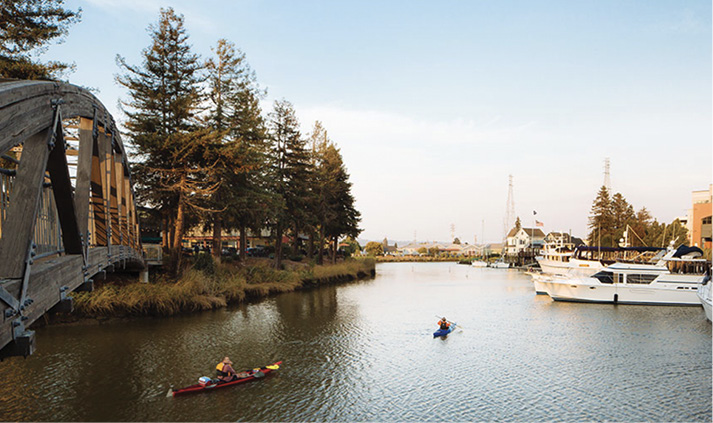
The Petaluma Watershed is located in southern Sonoma County and a portion of northeastern Marin. The Petaluma River Watershed drains 146 square miles and is about 19 miles long and 13 miles wide near the center of the City of Petaluma. Sonoma Mountain is the highest point in the watershed and its western slopes drain to the Petaluma River by way of four creeks, Lichau Creek, Lynch Creek, Washington Creek and Adobe Creek. The lower 12 miles of the Petaluma River flow through the marsh. The Petaluma Marsh is the largest remaining salt marsh in San Pablo Bay. It covers 5,000 acres and is surrounded by about 7,000 acres of reclaimed wetlands. The river flows under State Route 37 at Green Point and enters northwest San Pablo Bay just north of Petaluma Point. The river is fully tidal and the United States Army Corps of Engineers dredges this section to keep it navigable for gravel barges and pleasure craft.
The Petaluma River Watershed hosts several federally endangered animals including the red-billed harvest mouse, otters and Ridgeway’s Rails. The Ridgeway’s Rail is found in areas between San Francisco Bay and Southern California towards Baja. It is a bird that rarely flies and is about the size of a chicken. The otters found in the Petaluma River are common North American otters and can weigh up to thirty pounds, so be careful when you are out in your kayak. The red-billed harvest mouse can be found in the marshlands of the South Bay as well as the North Bay such as the Petaluma River.
The Petaluma River Watershed is also home to many endangered flora including soft Cordylanthus, Baker’s stickyseed, Burke’s goldfields, showy Indian clover and Sebastopol meadowfoam. Cordylanthus is also found in Richardsons Bay and is also known as bird’s beak because of the shape of the flowers it produces. Baker’s stickyseed and Sebastopol meadowfoam are commonly grown in the same habitat and thrive in Sonoma County. The Indian clover is an endangered herb that thrives on the California coastal ranges and grasslands such as those that are located around the San Francisco Bay.
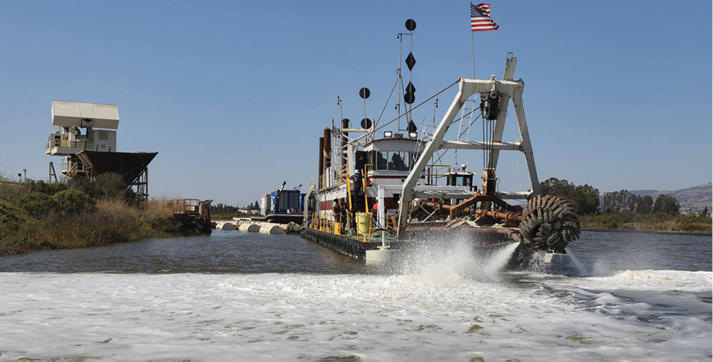
So, what does this all mean about the expanding of the Petaluma River? It means that the expansion could encroach into the areas some of the endanger wildlife call home. The Floathouse is also opening for community visitors and has a number of watercrafts for rent. The Floathouse on the Petaluma River is the only river access project that is being assembled dock by dock and boat by boat. It is fully approved and permitted. When Ann Buell of the Coastal Conservancy was asked about the Floathouse, she said “A small craft rental center in downtown Petaluma could serve as a hub for not only rentals, but also lessons and the dissemination of educational materials on boating safety, ethical paddling and the many interesting locations to visit along the Petaluma River. As importantly, the rental center would serve those who don’t own their own boat or paddle board or who don’t have the means to store or transport a boat or board to a launch site.” Another part of the Petaluma River expansion that will be worth it for us boaters is that we can get into the Petaluma Yacht Club. The Petaluma Yacht Club is located in the Petaluma Basin which has recently been dredged.
Check the club out at petalumayachtclub.com and feel free to reach out about cruise in opportunities or to visit the Petaluma Yacht Club.
Blackaller Buoy Gets A Face-Lift
While racing around the San Francisco Bay, as much as I loved sailing down from Blackaller, the real trouble has always been spotting the buoy. In December, Lisa Blackaller Williams cracked a bottle of champagne on the side of a new, and much larger, Yacht Racing Association buoy #16. The buoy is named after her father, Thomas “Tom” Blackaller, a two-time Star Class world champion, world champion in the International Six Metre class, three-time America’s Cup competitor and overall, a world-renowned sailor. Bill Dana, the commodore of St. Francis Yacht Club started off the ceremony followed by a series of toasts and roasts, followed by former crew members including, but not limited to, Ken and Kerry Keefe, Sean Svendsen, Russ Silvestri, Tad Lacey, Tony Chargin and Scott Easom.
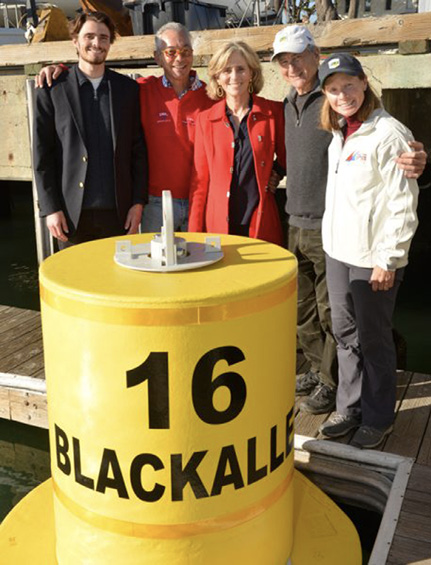
Scott Easom donated his time to paint and equip the new buoy with heavy ground tackle and an anchor. He plans to repurpose the old buoy as the Anita Rock offset after a little paint and reattachment of the heavy ground tackle and anchor. The new buoy, as well as the old was purchased with the guidance of the St. Francis Yacht Club Foundation, but the funds came from the Thomas D. Blackaller Jr. Buoy Fund. The idea came from a two-time Saint Francis Yacht Club sailor of the year, Bruce Stone. Bruce hopes that with the new and improved buoy, fewer sailors will overstand it and it will be easier to spot while on the water.
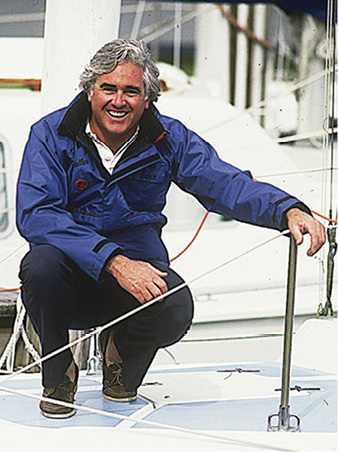
Tom Blackaller worked for Lowell North of North Sails as a sailmaker in the San Francisco Bay. He worked with North for a total of over a decade to help cover his costs of racing campaigns. Tom also had a very colorful personality on and off of the water, but regardless he loved the adrenaline of being on the water. He taught a number of kids that are still competing to this day. Some would say that Tom loved any type of competition whether it be on land or sea as he also competed in car racing. If you were a fan of Bay & Delta Yachtsman back in the mid 80’s you may also remember that Tom was a contributing editor to the magazine. Every month he kept all the readers up to date with his monthly column titled “Inside Racing.”
Tom passed away in 1989, but is still a well-known sailor throughout the San Francisco Bay and the sailing community.
Lights, Boats, And Parades
When December hits, everyone starts decorating and the lights shine bright around the harbors in the San Francisco Bay. Loch Lomond Yacht Club invited me out to attend their festivities up the San Rafael Channel, but due to unforeseen circumstances I was not unable to attend. I plan on attending San Rafael Canals parade next year. Loch Lomond Yacht Club, San Rafael Yacht Club, Marin Yacht Club and the Classic Yacht Association come together for this annual event, but they were not the only ones to put on a spectacular display of lights, and visits from the big guy in the red coat.
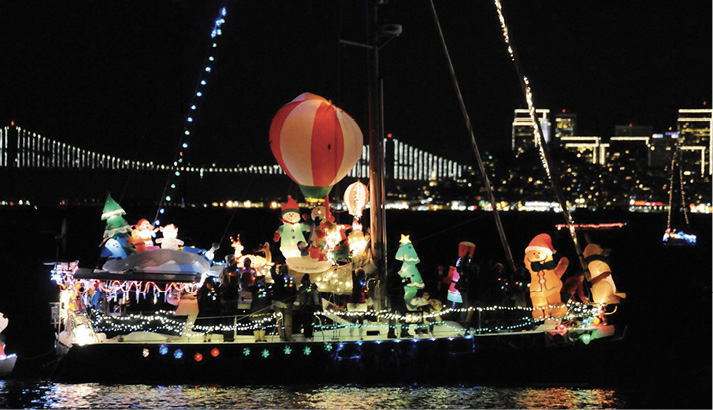
Sausalito Yacht Club made it hard to miss the array of lighted boats that took part in their lighted boat parade. Members and guests to the area enjoyed the spectacle scene of decorated boats that cruised by the waterfront for over an hour. This is longer than in years past. Following the festivities on the water, Sausalito had a light display in the sky with their fireworks.
The yacht clubs on the Estuary came together again this year for the Deck the Hulls Lighted Boat Parade. As the boats made their way past Oakland Yacht Club and Encinal Yacht Club to be judged, they continued down past the Pasta Pelican Restaurant, headed over to Jack London Square and ended over at Grand Marina.
Suisun City put on a breathtaking display of lights in their annual parade of boats at the waterfront. The beautiful waterfront had a Christmas market, ice skating rink and live music for visitors to enjoy until Santa arrived during the parade. After the parade the City of Suisun lit their Christmas tree and celebrated with fireworks as well. This year the waterfront in Suisun City also hosted their first annual Menorah Lighting where hot latkes and Chanukah cookies were available for guests as well. The menorah lighting offered an opportunity for the community to come together and learn about the Jewish holiday.
Richmond Yacht Club’s lighted boat parade was one that is up close and personal as it starts at the Richmond Harbor Entrance, goes through Potero Reach to Foss Pier and cruises around Brickyard Cove and Richmond harbors. St. Francis Yacht Club’s lighted boat parade along the city front draws crowds of busy shoppers to the calming waters.
Lighted boat parades are the symbol of the holidays truly beginning and are a time-honored tradition for my family and I, and next year I hope to be out on the water.
Sail Into The New Year
Everyone has their New Year’s traditions and for some it is competing in the Corinthian Yacht Club’s Resolution Regatta. The event does not kick off until about noon, so even if you are a bit dusty come out and enjoy the day the right way. Whether you are sailing in the Resolution Regatta or just out for a sail, being on the water is a great way to start off the new year. My family and I also make a point of being on the water as a sign of good luck.
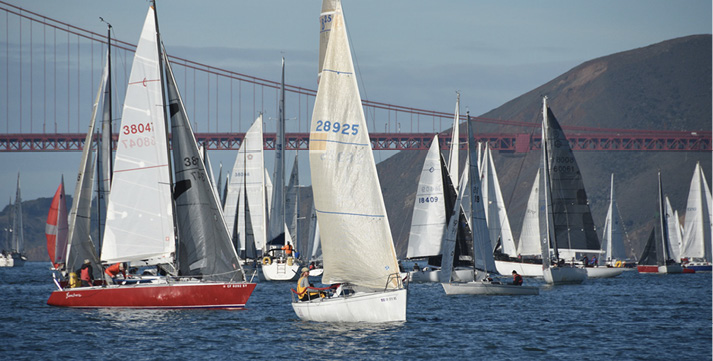
The Singlehanded Sailing Society is having their annual Three Bridge Fiasco. Spectators will tell you it makes quite the fiasco on the water. The Three Bridge Fiasco is started and finishes off at Golden Gate Yacht Club and is usually on the last weekend of January. The course consists of Yerba Buena Island, Red Rock and Blackaller Buoy, but there is a twist. The twist is that there are about 300 other sailors out there with you, but you can start, round every mark and finish in any direction and choose which marks you want to do and in what order. If you are able, come and watch the fiasco from the shore by the St. Francis Yacht Club and Crissy Field.
Many yacht clubs have what they call Midwinter Series. This is an easy way to get out on the water and learn about racing in a competitive way, but the light winds make it easy to learn more as you go. Corinthian Yacht Club celebrates the 69th Midwinters this year with their well-known and high turnout event. Other yacht clubs that have Midwinter events are Berkeley, Coyote Point, Encinal, Golden Gate, Island, Oakland, Sausalito and many more throughout the San Francisco Bay. If small boats are more your style, the Richmond Yacht Club has a Small Boat Midwinters. There is also sailing at Lake Merritt Sailing Club throughout these winter months. The annual Golden Gate Bullship Race which takes place in El Toros is on April 23, and sailors are getting geared up for it.
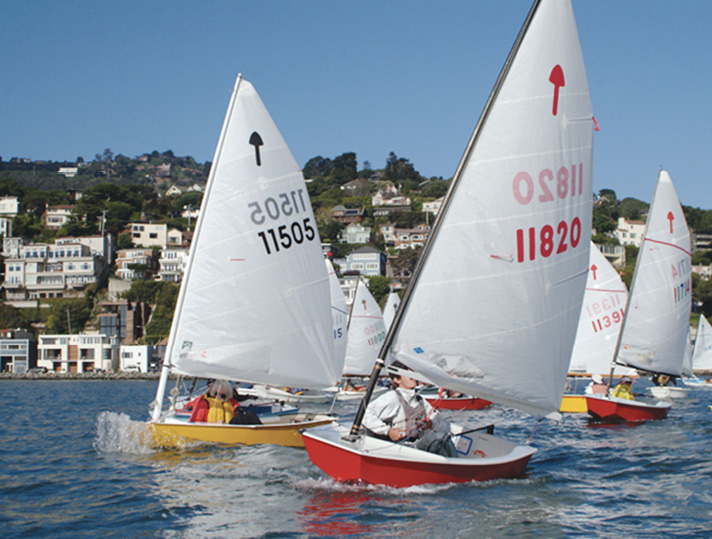
The Golden Gate Bullship Race is hosted by the Golden Gate Yacht Club. It starts at the at the Sausalito Yacht Club and finishes up at Golden Gate Yacht Club. This race did not begin as a race at all, but rather a way to prove the seaworthiness of the vessels. The eight-foot plywood boats were home-built and intended to be tenders for ferrying people to and from larger vessels. The official beginning of what is now done in El Toro sailboats, mostly made of fiberglass, but some brave souls still trust the wood as back in 1953. The race is not for the weak-minded and faint of heart as it is an all-day race where it is only sailors against the elements and the tides. In 1962 the race reached over 130 entries as it became a personal test for many, and because of the large number of participants it made rescues difficult. The organizing authority made the decision to cap the entries at 100 for the years to come.
The number of entries has decreased over the years to about 20 die hard individuals that have the enthusiasm of all of those that are missing out. Many of the original participants show up and provide emotional support to the contestants with a breakfast and assistance in launching their boats. Trash talking among veterans is almost a given when it comes to this race because anyone can win when it comes time. Sailors from around the San Francisco Bay arrive to either race the event or provide support aboard the “Cow Boats.” The “Cow Boats” work as a safety net for the competitors that may need a little assistance and they assist in towing the El Toros out to the starting area.
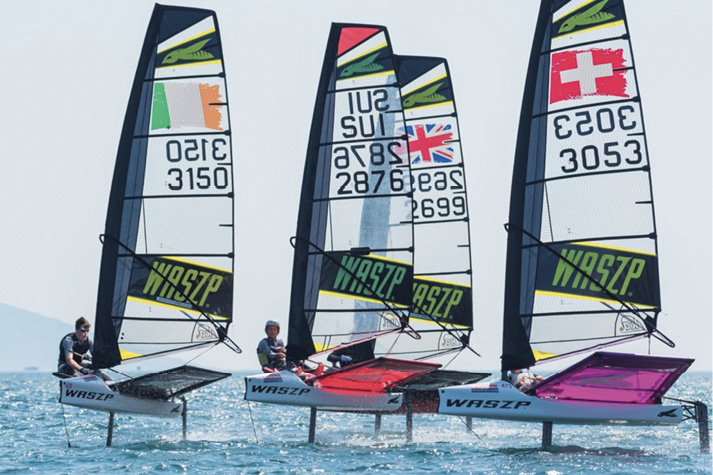
The race begins off of the southernmost restaurant in Sausalito, the Trident, the same place it has for many decades. The first gun is at 0900 as it provides for less potential hazards and calmer seas. The race course is simple, but if you do not plan it right the “Cow Ships” come herd you up as the boundary lines are easy to pass if you get caught in the tide at the wrong time between the Golden Gate Bridge and Alcatraz. In years past, the fleet usually divides itself with some interesting results. Some stay true to their winning ways of years past and others change their strategy from year to year.
Once all of the competitors have finished or made their way to the St. Francis Yacht Club docks and have loaded up their vessels for transportation home, the group gathers on the grass for the annual lunch. The luncheon is attended not only by participants, but their families, alumni and “Cow Ship” operators and lasts into the mid-afternoon. Along with the luncheon is the awards ceremony. Trophies are not the traditional ones that you would expect like “oldest skipper” or “rookie sailor.” The most unique of them all is the “tails end,” and that is a bull’s tail mounted on a wooden plaque for the final finisher. The Golden Gate Bullship Race may not be for the faint of heart, but has proven that it is for the kid in all of us.
Be warned that Waszps are coming to the San Francisco Bay Area. The Waszps American Championships are scheduled for March, and they will bring some of the top sailors out to the water. Waszps are currently the safest foiling boats for the speeds they can reach. The design is simple when you eliminate side stays, aluminum foils and wishbone booms. They create a boat with very little opportunity for a sailor to get hurt. Waszps are extremely light weight and a popular class worldwide, including some Sail GP sailors, as well as America’s Cup sailors. Be on the lookout for the little stingers in mid-March when you are out on the water.
Let’s make 2022 the best year yet! Feel free to contact me at jillian@yachtsmanmagazine.com to let me know where I can catch you on the water.



